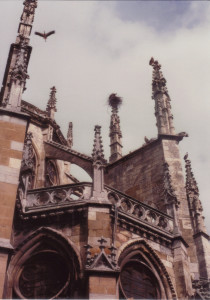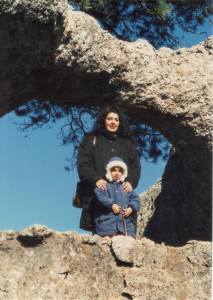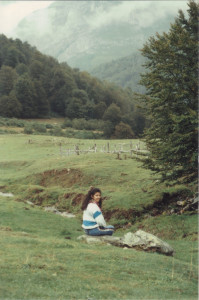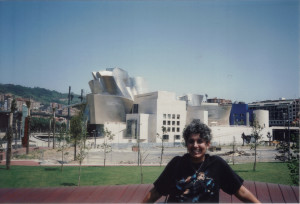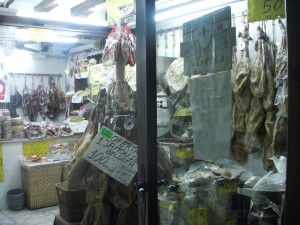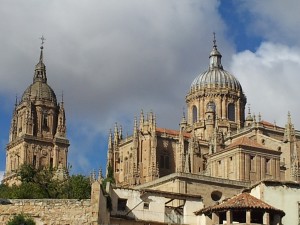Ask anyone who knew me in my first years in Spain and they’ll tell you I was obsessed—how could I help it? As I was walking down the street I would look up at the rooftops of the highest buildings (usually churches) and I’d see these humongous nests, maybe 5 feet across and several feet deep. And if I was really lucky, I might see the object of my obsession, the tenant of these twiggy creations: white storks, standing almost my height, with their crisp white and black feathers and skinny red legs. I had grown up in Ohio, you see, and I had never laid eyes upon a cigüeña in real life; I promise you that watching these birds, whose wingspan is from 5 to 7 feet across, flying overhead, is breathtaking. (By the way, since I’m going to use this term a lot, might as well sneak in a pronunciation lesson: it’s “thee-goo-EH-nee-ah,” with a hard “th” at the beginning, as we learned in my blog post “Una Cerveza Por Favor“).
In 1986, the Catedral de León, which I passed every morning on my way to classes, had 52 stork nests on it—yes, I circled the whole cathedral, counting them. Several times, in fact–I was so struck by the sight! Sometimes there would be a bird on each and every spire. But, cigüeña nests weigh over 100 pounds, and the Catedral de León eventually had to re-locate many of these nests as they were damaging the fine stone spires that were hundreds of years old. I’m so glad I got my pictures (including the two above) before then!
According to Wikipedia, cigüeñas became prevalent in Europe after trees were cleared in the middle ages to make room for lots of farms. As carnivorous hunters, cigüeñas spend much of their time out in the fields, hunting for small critters to eat. When the sun begins to set, they return to their nests, coasting in graceful circles over rooftops until they settle down for the night.
Early mornings you can hear them clattering their beaks, a sound which the Spanish refer to as “machacando el ajo”, pounding up some garlic for the day’s cooking. The first time I heard it I thought it was kids beating sticks together in quick succession, and was awed to find out that that loud, rhythmic sound, which echoed through the streets, was actually being made by these majestic birds. Here’s a good video so you can hear them.
Although their numbers declined in the 18th and 19th centuries, cigüeñas have been an integral part of the Spanish–and European–landscape for hundreds of years. As a matter of fact, since they love to eat mice, rats, snakes and insects, their presence on rooftops was welcomed. According to the website “Waste Ideal” Spain has the largest number of cigüeñas—25,000 breeding pairs. (By comparison, France, which is similar in size to Spain, only has 1,000 nests.) There’s even an aphorism, which I didn’t include in my previous blog about Spanish sayings, which goes “Por San Blas, la cigüeña verás. Si no la vieres, año de nieves.” If you don’t see the storks by San Blas (a saint whose day is in early February) it will be a year of lots of snow. Interestingly, I also read that this aphorism, also hundreds of years old, is not holding true anymore because with the global climate crisis, temperatures are remaining warmer, and many cigüeñas no longer fly off to Africa for the winter.
While I was watching a video of storks in the wild, and another one of cigüeñas nesting on top of different buildings in La Rioja, (set to relaxing classical music, with some really gorgeous footage,) I was reminded that lots of other birds—from pigeons to owls– make their homes in the lower parts of stork nests. A bird apartment building!
And finally, though I never saw these, Spain is also home to the rare black cigüeña. Here is some footage about these black storks, eating in a river, also set to classical music.
So the next time you’re wandering around in Spain, look up and enjoy the site of this magnificent bird—and, let me know if you, too, become obsessed with cigüeñas!
If you enjoyed this blog post, you might also like my series of novels, Bueno, Sinco and Brujas, which takes place in Santander, Spain.



